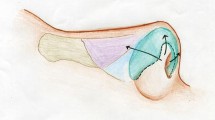Abstract
Background
A novel technique for maintaining nasal tip support and external nasal valve integrity is proposed. The procedure involves mobilizing the lateral crus to a more cranial position after altering its shape from convexity to a more flat shape.
Methods
With the described technique, the lower lateral cartilage is dissected free from the skin in a retrograde fashion after an intercartilaginous incision. The ligament between the lateral crus and the upper lateral cartilage is cut. The vestibular mucosa is not freed. With this maneuver, the lateral crus usually flattens sufficiently. When the convexity flattens, an extra millimeter of cartilage at the cephalic end is gained in the horizontal dimension. When the cut vestibular mucosa is sutured back to its place, the cephalic end of the lateral crus is advanced over the upper lateral cartilage. This technique allows durable support to maintain patency of the nasal valve. No bridges are burned because no cartilage is excised. The surgeon is left with the flexibility to modify the result on the operating table.
Results
The technique was successfully used for 48 consecutive patients over a 3-year period. All the operations were primary rhinoplasties performed using a closed technique. The mean age of the patients was 32 years. For 72% of the patients, septoplasty also was performed. None of these patients had to undergo reoperation.
Conclusion
The authors emphasize the importance of the lateral crus in rhinoplasty and demonstrate that good results at the tip of the nose can be accomplished without cephalic trimming, averting related complications in selected cases.








Similar content being viewed by others
References
Hatzis GP, Sherry SD, Hogan GM, Finn RA (2004) Observations of the marginal incision and lateral crura alar cartilage asymmetry in rhinoplasty: a fixed cadaver study. Oral Surg Oral Med Oral Pathol Oral Radiol Endod 97:432–437
Sheen JH (1978) Aesthetic rhinoplasty. C.V. Mosby, St. Louis
McKinney P (2000) Management of the bulbous nose. Plast Reconstr Surg 106:906–917
Rohrich RJ, Raniere J, Ha RY (2002) The alar contour graft: correction and prevention of alar rim deformities in rhinoplasty. Plast Reconstr Surg 109:2495–2505
Rees TD, LaTrenta GS (1994) Aesthetic plastic surgery, 2nd edn. Saunders, Philadelphia, pp 159–244
Hamra ST (1993) Repositioning the lateral alar crus. Plast Reconstr Surg 92:1244–1253
Hoefflin SM (1994) Geometric sculpturing of the thick nasal tip. Aesth Plast Surg 18:247–251
Fontana A, Muti E (1997) Alar lateral crus in nasal tip surgery. Aesth Plast Surg 21:43–47
Tellioglu AT, Cimen K (2007) Turn-in folding of the cephalic portion of the lateral crus to support the alar rim in rhinoplasty. Aesth Plast Surg 31:306–310
McKinney P, Stalnecker M (1983) Surgery for the bulbous nasal tip. Ann Plast Surg 11:106–113
Ishida LC, Ishida J, Ishida LH, Passos AP, Ferreira MC (2006) Power instrumentation for shaping the nasal cartilages. Ann Plast Surg 56:375–379
Ali-Salaam P, Kashgarian M, Davila J, Persing J (2002) Anatomy of the Caucasian alar groove. Plast Reconstr Surg 110:261–266
Patel JC, Fletcher JW, Singer D, Sullivan P, Weinzweig J (2004) An anatomic and histologic analysis of the alar–facial crease and the lateral crus. Ann Plast Surg 52:371
Bruintjes TD, van Olphen AF, Hillen B, Huizing EH (1998) A functional anatomic study of the relationship of the nasal cartilages and muscles to the nasal valve area. Laryngoscope 108:1025
Han SK, Lee DG, Kim JB, Kim WK (2004) An anatomic study of nasal tip supporting structures. Ann Plast Surg 52:134
Author information
Authors and Affiliations
Corresponding author
Rights and permissions
About this article
Cite this article
Keskin, M., Tosun, Z. & Savaci, N. The Importance of Maintaining the Structural Integrity of the Lateral Crus in Tip Rhinoplasty. Aesth Plast Surg 33, 803–808 (2009). https://doi.org/10.1007/s00266-009-9358-4
Received:
Accepted:
Published:
Issue Date:
DOI: https://doi.org/10.1007/s00266-009-9358-4




